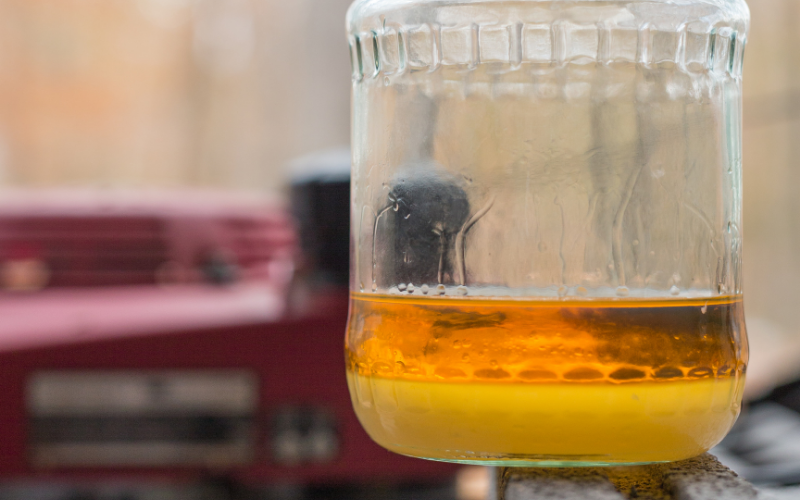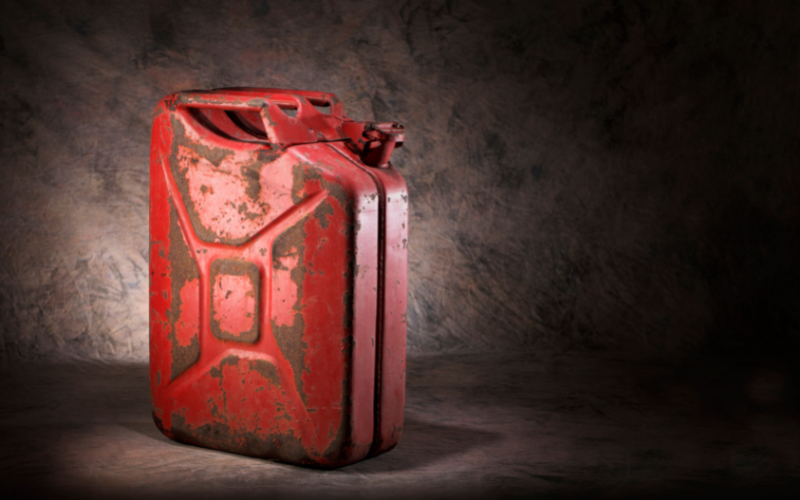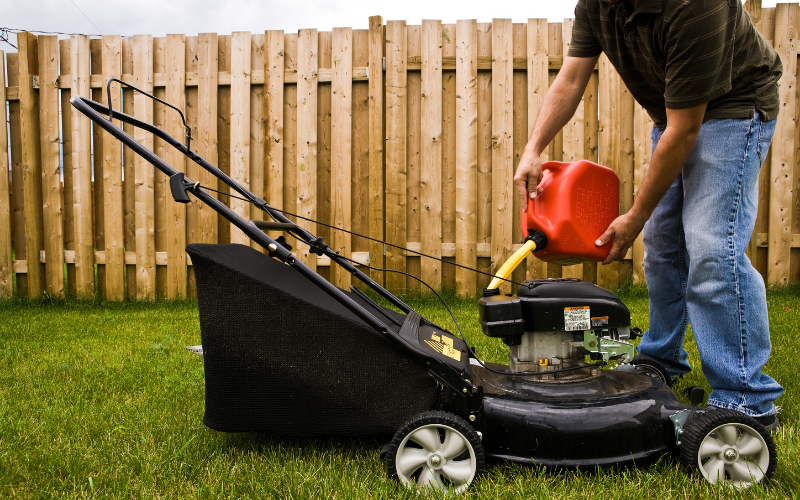There are lots of reasons that a gas lawn mower might not start up, but without a doubt one of the most common that I hear of is water in the tank. If you don’t know much about small engines, it might not seem like that big of a deal. A little bit of water never hurt anybody, right?! WRONG! Water in a gas mower can be the source of much frustration – no one loves yanking on the starter cord over and over again – until you take steps to address it.
Signs that You Have Water in Your Gas Mower
Water and gas don’t mix. Water is denser and will sink to the bottom of the tank. If you peer into your tank you might see what look like bubbles or “spots” at the bottom; that’s water. And because it’s sitting at the bottom of the tank, it’ll be sucked up into the fuel line before the gas the next time you try to use your mower.

When there’s water in a gas mower, here is what you’ll likely experience:
Lawn Mower Won’t Start
You crank and crank that pull cord, but nothing happens. There are a few potential causes here, but one of them is water in the engine. And if this is the problem, the fact that it’s not starting probably means that there’s a lot of water in there, as no gas is getting through whatsoever.
Splutters into Action Before Cutting Out
This is what will likely happen if your tank doesn’t have quite as much water in it as in the example above. Some fuel is able to get through and allow you to start it up, but it struggles like hell to maintain enough fuel for combustion and cuts out. This is the most common situation I’ve experienced, although the first scenario is quite common on the first start after winter if you forgot to winterize your lawn mower before storing.
It Runs, But Not Well
If your mower is running, but revving up and down the whole time, this could also be an indication that there’s some water in the fuel system. Not enough to stop the engine from running, but it still significantly affects performance.
There you have it. Three potential indicators that there’s water in your gas mower. Whichever you experience, the objective will be the same: Get that water out.
But first, let’s just quickly explain how the water in your gas mower most probably got there in the first place. Then you might be able to avoid history repeating itself in the future.
Water in My Gas Mower: How Did It Get There?
There are two common ways that water gets into your gas lawn mower:
You’re Using Gas Containing Ethanol
You might have heard people say that gas containing ethanol is no good for lawn mowers. This is why. You see ethanol is basically a magnet for water. It draws the moisture out of the air, and then it condenses on the inside of your tank and sinks to the bottom. This is a particularly common occurrence during the winter break if you don’t either drain the old fuel out or you don’t add a fuel stabilizer. And if the tank is half-empty or less, think of all of that air in the tank…

Leaving the Gas Cap Off Your Mower or Storage Can
While you might not have realized the gas you’re using can cause water to accumulate when your mower is sat unused for long periods, this situation is a bit more common sense. You definitely do not want to be leaving the gas cap off your mower or gas canister for prolonged periods. This will also cause condensation and water build-up.
What You Need to Do If You Have Water in a Gas Lawn Mower
You have a couple of options if you determine that the cause of the lawn mower problems you’re experiencing is water.
Remove Your Fuel Tank, Clean It and Fill with Fresh Gas
This option is definitely what I’d personally do. It’s a little more involved, but it’s less risky for the “health” of your mower.
You’re basically going to need to remove the fuel tank from your mower so you can completely drain it, removing all of the old gas that is contaminated with water. You won’t need much to do this:
- Socket wrench (3/8-inch + ½-inch socket will usually do the trick)
- Phillips screwdriver
- Flathead screwdriver
Disconnect the spark plug, remove the air filter and then proceed to take out the bolts that are connecting the fuel tank to the mower (there are often 2 on most mowers). Then just wiggle the tank gently from side to side to loosen it, and remove the governor springs (bend them down), and you should then be able to pull the gas tank free.
You can then empty out all of the old gas (+ water). I’d recommend disposing of this into a special container that you only use for that purpose. You’re then going to need to remove the primer assembly from the tank, as there’s normally a small pickup reservoir underneath it that could contain some of the contaminated gas. This will be screwed down and there will also be a gasket and a diaphragm (be careful with those) that you’ll need to take off. Then you can clean up the little reservoir I mentioned.
What I do now is take some folded paper towels and push them into the tank to clean up any residue that is still coating the bottom and sides of the tank. You can push this in with a screwdriver so that it reaches all corners of the tank, and then use some pliers to pull it out when you’re ready.
Then it’s just a case of re-attaching everything and adding fresh gas. You should then be good to go!

Option Two: Add Some Isopropyl Alcohol to Your Fuel Tank
I’ve never actually done this, and I’m not sure I’d recommend doing it either. Why? Well because your mower engine likely isn’t designed to burn alcohol and there may be some unexpected “side effects”. Having said that, I have seen folks online mention that they’ve done this when they’ve had a small amount of water in the fuel tank, and it worked. I think that’s the trick though – I definitely wouldn’t try this if you have a lot of water in the tank. You’re much better off removing the tank and following the steps I outlined above in that situation.
You can actually use isopropyl alcohol, methyl alcohol or ethyl alcohol for this. Just make sure you get 99% alcohol content though, as if you get a bottle of 70% you’re just adding more water…You might be wondering how in the hell adding alcohol to the equation is going to help?
So remember we said earlier that gas and water don’t mix. The gas rises above and traps the water beneath it. But alcohol and water DO MIX. And the alcohol WILL BURN, and it’ll take the water with it.
But as I said before, your lawn mower probably isn’t set up to burn alcohol, so do this at your own risk. I always go with tank removal and a thorough clean.
Water in a Gas Mower is Not a Problem that Will Fix Itself
You must take action if your find water in a gas mower, as it can render your mower useless and potentially lead to irreparable damage through corrosion if left long enough.



Leave a Reply